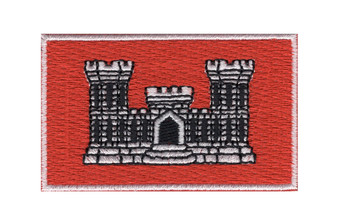Description
U.S. Army Corps of Engineers Patch 4.0" x 4.0" Embroidered Patch with Iron-On Backing
Superior Materials: Made with premium polyester thread and durable twill fabric, ensuring long-lasting color and strength.
Advanced Embroidery Technology: Crafted using the most advanced embroidery machinery, guaranteeing intricate detail, sharp lines, and consistent quality every time.
Easy Iron-On Application: Features a heat-activated adhesive backing for quick, no-sew attachment. Simply position, iron, and press for a secure bond.
Versatile Use: Perfect for personalizing jackets, backpacks, uniforms, or any fabric surface that needs a touch of personality.
Durable and Washable: Designed to withstand everyday wear and occasional washing without fading or fraying.
Formations & Origins
The U.S. Army Corps of Engineers traces its origins back to June 16, 1775—the same day the Continental Congress formed the Continental Army. George Washington quickly recognized the need for military engineers to fortify positions, build defenses, and plan battlefield movement. What began with a few skilled volunteers has become one of the oldest and most respected technical institutions in the world.
The Corps was formally organized in 1802 and made permanent by Congress. Since then, it has served both as a critical arm of the Army and as a civil engineering force that has literally shaped the landscape of the United States. Its emblem—a white castle on a red background—has become a symbol of ingenuity, precision, and strength.
Notable Commanders
The Corps has been led by many brilliant minds, including General George Washington himself, who directly oversaw early engineering operations. One of the most prominent names in its history is General Andrew A. Humphreys, who served as Chief of Engineers after the Civil War and helped modernize America’s coastal defenses.
More recently, Lieutenant General Todd Semonite served as the 54th Chief of Engineers and Commanding General of the U.S. Army Corps of Engineers, playing a key role in infrastructure recovery efforts and emergency response across the country.
Major Campaigns/Operations
The U.S. Army Corps of Engineers has supported combat operations in every major war in American history:
-
In the Revolutionary War, engineers built fortifications at Dorchester Heights that forced the British evacuation of Boston.
-
In the Civil War, Union engineers constructed bridges under fire, mapped battlefields, and fortified positions like Vicksburg and Chattanooga.
-
In both World Wars, the Corps built roads, airfields, and supply depots—often in harsh, undeveloped terrain.
-
In Vietnam, engineers cleared jungle, built firebases, and constructed logistical routes like the famous “Red Ball Express” concept.
-
In Iraq and Afghanistan, the Corps supported forward operations, constructed bases, and restored war-torn infrastructure.
Outside of combat, they have led missions during natural disasters, humanitarian crises, and civil emergencies—rebuilding after hurricanes, floods, and earthquakes with speed and skill.
Specialized Role/Equipment
The Corps is composed of both military personnel and thousands of civilian engineers, architects, and scientists. Their specialties include civil engineering, structural design, flood control, construction, environmental management, and disaster relief.
Military engineers use specialized equipment for demolition, bridge-building, route clearance, and field fortification. Their work is essential in enabling the mobility of friendly forces and denying it to the enemy.
On the civil side, the Corps manages over 700 dams, 12,000 miles of commercial inland waterways, and the nation’s coastal navigation infrastructure. They also lead in environmental restoration and water quality projects.
Acts of Heroism
While engineers may not always be on the front line, they often find themselves in harm’s way. In WWII, Engineer Combat Battalions stormed the beaches of Normandy alongside infantry—clearing mines and erecting bridges under fire.
In Korea, engineers blew bridges to slow enemy advances and built new ones under the cover of darkness. In Vietnam, combat engineers rode with convoys through ambushes, patched cratered roads, and defused booby traps.
One of the most heroic moments in modern Corps history came during Hurricane Katrina in 2005. Corps personnel worked around the clock—some without sleep for days—to shore up failing levees and begin the monumental task of rebuilding New Orleans.
Legacy & Notable Achievements
The U.S. Army Corps of Engineers is unique in military history—a force as skilled with slide rules as with sledgehammers. Its legacy includes the Washington Monument, the Panama Canal (U.S. phase), the Hoover Dam, and countless military airfields, hospitals, and bases.
They have redefined the American landscape and saved millions through their flood control and disaster relief efforts. Their motto, “Essayons” (French for “Let us try”), embodies the Corps’ unrelenting pursuit of solutions in the face of every challenge—whether it's building a bridge in a war zone or restoring a hurricane-ravaged city.
To wear the Corps of Engineers patch is to wear the symbol of America’s builders, problem solvers, and unsung heroes. It's not just about strength—it’s about structure. Not just about war—but about rebuilding what war leaves behind.






